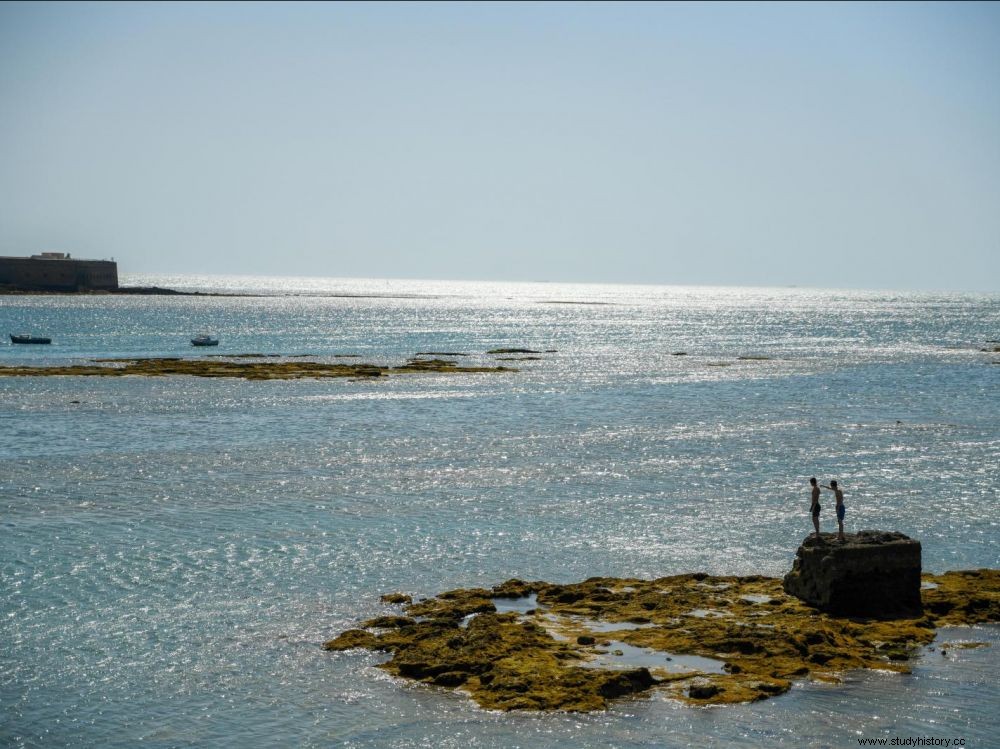A Spanish team of archaeologists has announced that they have located, thanks to LiDAR, important underwater remains in the bay of Cadiz, on the Andalusian coast. They could be the remains of one of the most famous sanctuaries of antiquity - that of Hercules Gaditanus, sought after for centuries.

A view of Cadiz beach. Researched for centuries, the site of the Temple of Hercules Gaditanus (or Temple of Melqart in its Phoenician version) may have finally been located in the Bay of Cadiz, off the southern coast of Spain.
Time has the particularity of making you forget the past splendor of certain places. There is one which, for example, has no more sumptuousness than the descriptions made of it in literature by its contemporaries. The Temple of Hercules Gaditanus, named after the ancient port of Gades - present-day Cadiz, Spain - was said to have been one of the most important places of worship in the western Mediterranean during Antiquity. Built by the Phoenicians in the 9th century BC. J.C. at least, perhaps in the 12th century, it would have been originally dedicated to the god Melqart (or Melkart), equivalent of the Greek demi-god Heracles, before being transformed by the Romans into a space devoted to the cult of Hercules, Roman evolution by Melqart.
According to Greco-Roman archives, illustrious figures such as the Carthaginian conqueror Hannibal Barca, considered one of the greatest military tacticians in history, or Julius Caesar who, according to some sources , would have shed a tear in front of a representation of the Emperor Alexander the Great:he feared never to equal the greatness of his hero.
A legendary site
Long sought after, never found, the temple of Hercules Gaditanus has therefore become over the centuries an "archaeological sea serpent", one of those mythical places about which specialists are unable to agree. Will they finally come to an agreement, when a team of archaeologists from the University of Seville, supported by the Andalusian Institute of Historical Heritage (IAPH), claims to have spotted in a shallow channel in the bay of Cadiz, between the locality of Camposoto and that of Sancti Petri, the remains of a monumental structure which could be related to that of the famous sanctuary?
"We researchers are very reluctant to turn archeology into a spectacle, but in this case we are faced with spectacular discoveries. They are of great importance" , said Francisco José García, director of the Department of Prehistory and Archeology at the University of Seville, during the presentation, on December 15, 2021, of the results of this research at the Center for Underwater Archeology in Cádiz.

In the center, the structure revealed in the Caño de Sancti Petri. Credits:University of Seville
The exciting hypothesis, supported by Ricardo Belizón, a doctoral student in archeology at the University of Seville, was formulated thanks to aerial photography and digital terrain model technology, or DTM, of which LiDAR is one of the variations. The site that caught the researcher's attention is a huge marshy canal dominated by an islet and by the castle of Sancti Petri, a 13th century fortress. For the moment, this is only an inspection carried out at a good distance. Any excavations will only be organized in the event of successful geophysical prospecting. It is difficult today to imagine that it is not:on topographic surveys, the contours of a rectangular enclosure spanning an area of approximately 4.5 hectares appear unequivocally.
Archaeological puzzle
At the beginning of his work, Ricardo Belizón's objective was to reconstruct the paleo-landscape of 3,000 years ago. A tour de force, given the frequent storms and intense erosion that plague the area, close to the Strait of Gibraltar. If archaeological excavations were to be carried out there, they would necessarily be interrupted by the tides, making the task of the experts, forced to decamp every three hours, technical and acrobatic to say the least.
In an interview with the Spanish daily El País , the expert claims to have discovered during his virtual research "a completely anthropized coastline, with a large building [the possible temple], several breakwaters, moorings and an inner port." The main structure alone, 300 by 150 meters approximately, was to occupy the entire area of the island on which it stood. Now submerged 3 to 5 meters under water, it would correspond in this to the descriptions found of it in classical literature. According to these same sources, access to the very busy sanctuary was allowed to Phoenician, Punic and Roman ships. Its entrance was marked by two columns - the Pillars of Hercules, a symbolic representation of the two mountains flanking the Strait of Gibraltar - which themselves included a representation of the Twelve Labors of the Hero. As for the interior, there was a temple and a protected part where a sacred flame burned continuously.
For more than two centuries, the area has yielded important archaeological discoveries, now exhibited in the Cadiz Museum, such as monumental sculptures of Roman emperors in marble and bronze or even statuettes from the Phoenician era. . They are the ones who partly allowed to delimit the location of the temple of Hercules Gaditanus. If it is indeed a temple, and this temple... To verify it, it will be understood, the archaeologists will have to arm themselves with courage and ingenuity.
